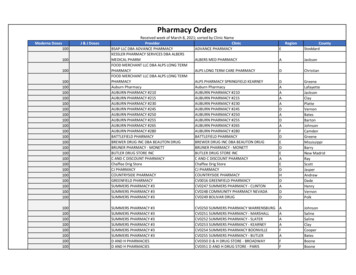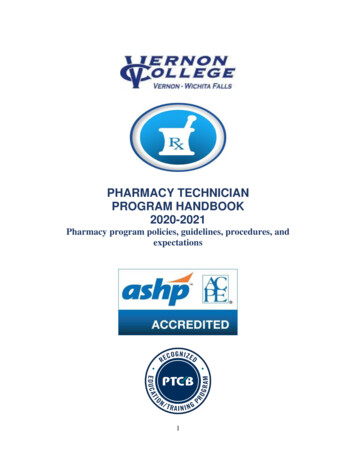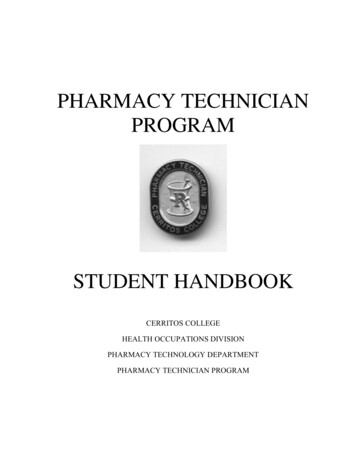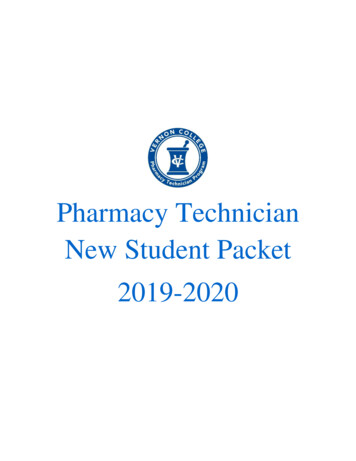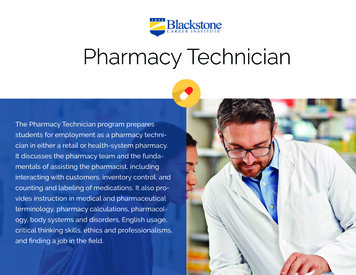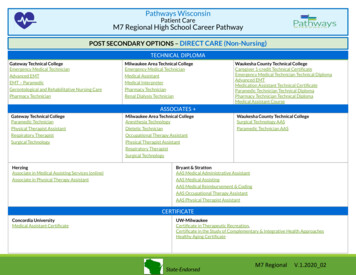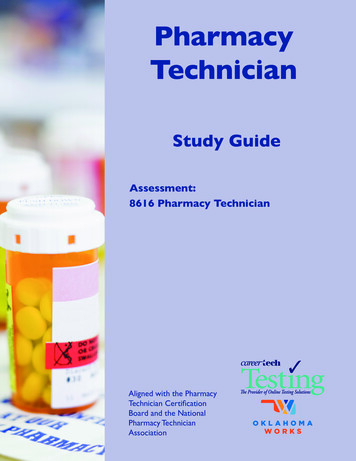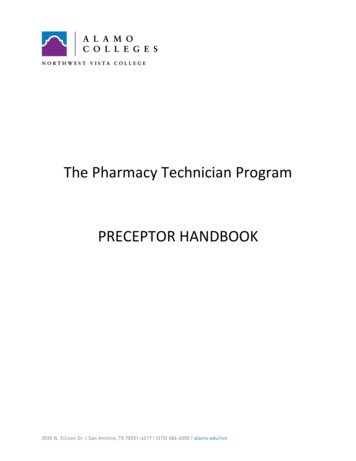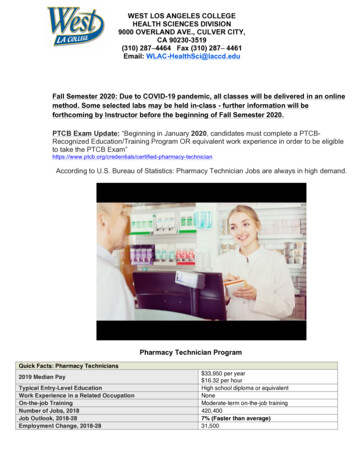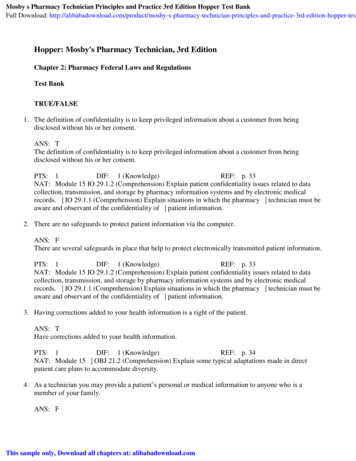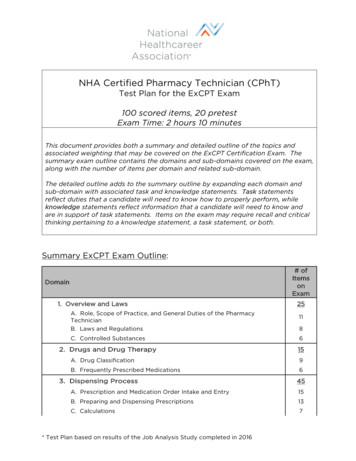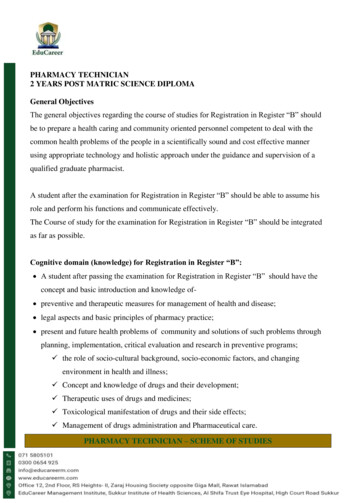
Transcription
PHARMACY TECHNICIAN2 YEARS POST MATRIC SCIENCE DIPLOMAGeneral ObjectivesThe general objectives regarding the course of studies for Registration in Register “B” shouldbe to prepare a health caring and community oriented personnel competent to deal with thecommon health problems of the people in a scientifically sound and cost effective mannerusing appropriate technology and holistic approach under the guidance and supervision of aqualified graduate pharmacist.A student after the examination for Registration in Register “B” should be able to assume hisrole and perform his functions and communicate effectively.The Course of study for the examination for Registration in Register “B” should be integratedas far as possible.Cognitive domain (knowledge) for Registration in Register “B”: A student after passing the examination for Registration in Register “B” should have theconcept and basic introduction and knowledge of preventive and therapeutic measures for management of health and disease; legal aspects and basic principles of pharmacy practice; present and future health problems of community and solutions of such problems throughplanning, implementation, critical evaluation and research in preventive programs; the role of socio-cultural background, socio-economic factors, and changingenvironment in health and illness; Concept and knowledge of drugs and their development; Therapeutic uses of drugs and medicines; Toxicological manifestation of drugs and their side effects; Management of drugs administration and Pharmaceutical care.PHARMACY TECHNICIAN – SCHEME OF STUDIES
1st YearPaperSubjectMarks1.Anatomy & Physiology (Written)100 Marks (20 80) Marks2.Biochemistry & microbiology (written)100 Marks (50 50) Marks3.100 Marks5.Pharmacognosy (written)Pharmaceutics-I(General, Physical And Dispensing) (Written)Anatomy & Physiology (Practical)6.Biochemistry and microbiology (practical)100 Marks (50 50) Marks7.100 Marks4.Pharmacognosy (Practical)Pharmaceutics-I (General, Physical And Dispensing))Practical2nd YearPharmaceutics-II (Industrial And Quality Control)(Written)Pharmacology (Written)Pharmaceutics-III(Hospital And Community Pharmacy) (Written)Social Behavior, Law and Ethics (written)5.Computer100 Marks6.Pharmaceutics (Industrial) Practical100 Marks7.Pharmacology (Practical)100 Marks4.8.1.2.3.100 Marks100 Marks (20 80) Marks100 Marks100 Marks100 Marks100 Marks100 Marks
CHAPTER VII - COURSES OF STUDY AND DISTRIBUTION OF SUBJECTS ANDPRACTICALS FOR EXAMINATION FOR REGISTRATION IN REGISTER “B”.12. Courses of study for Examination for Registration in Register “B”. – The detailsregarding course contents of each subject/paper will be as under:ANATOMY & PHYSIOLOGY (WRITTEN)Paper IMarksPart- I100 (20 80)Anatomy1. Introduction to Anatomy2. Anatomical Terminologies3. Surface AnatomyPhysiology1. Introduction to Physiology2. Structure of Cell and Tissues of the Bodyi) Bone Structure, Types of Bones and Jointsii) Muscles (Structure of Skeletal, Smooth & Cardiac Muscle)3. BLOOD: Composition of blood (RBC, WBC and Platelets), Fate of Red Blood cells, Bloodgroups, Rh factors, E.S.R. Blood coagulation, Anaemias.4. CIRCULATORY SYSTEM: Properties of the cardiac muscle. Heart beat. Cardiac cycle.ECG. Blood pressure. Pulse. Haemorhage. Lymph.5. RESPIRATORY SYSTEM: Mechanics of respiration. Pulmonary ventilation. Lungsvolume and capacities. Carriage of O2 and CO2 by the blood. Regulation of breathing(Nervous & Chemical control).6. SKIN: Structure, Functions of skin, Temperature regulation by Skin.7. DIGESTIVE SYSTEM: Introduction to Digestive juices-saliva, Gastric juice, pancreaticjuice, Bile and intestinal juices; their composition. Movements of the stomach and intestines.Functions of liver and gall bladder.8. URINARY SYSTEM: Urine formation and composition of urine.
9. PHYSIOLOGY OF NERVE AND MUSCLE: General introduction to Nervous andMuscular system.10. NERVOUS SYSTEM: General introduction to Nervous and Muscular system.11. SPECIAL SENSE: Introductory knowledge of structure and functions of the specialsenses.12. ENDOCRINOLOGY: Definition of Hormone. Nature, Function and action of Hormone.
BIOCHEMISTRY & MICROBIOLOGY (WRITTEN)Paper 2MarksPart- I100 (50 50)BIOCHEMISTRY (50 marks)1General Introduction and Basic Biochemical Principles2General introduction, Basic Chemistry, Nature and Classification and functions of :Carbohydrates, Lipids, Proteins and Amino acids, Nucleic acids, Vitamins, Hormones,Enzymes3. Role of Vitamins, Physiological role of Fat-soluble Vitamins (A, D, E and K) and Watersoluble Vitamins (Thiamin, Riboflavin, Pantothenic acid, Niacin, Pyridoxal phosphate, BiotinFolic acid, Cyanocobalamin - members of B-complex family - and Ascorbic acid)4.Introduction to Biotechnology and Genetic Engineering5.Acid-Base and Electrolyte Balance in Human body.MICROBIOLOGY (50 marks)1.Introduction and Scope of Microbiology2.Nomenclature and classification of Micro-organisms.(I) The Bacteria:a. Classification of Bacteria.B. .Culture Media, Bacterial cultures and stainingMethods.(II) The Viruses: Nomenclature and Classification of Viruses(III) Introduction to Fungi/Yeast/Molds:3.Introduction to Microbiology of air, water and soil.4.Sterilization/Disinfection.a. Introduction to sterile area and clean area.pharmacyb. Methods and application in5.Fermentation. Pharmaceutical Products produced by fermentation process.6.Definitions of the following:
Immunity, autoimmunity and tolerance. Antigen. Antibodies. Antigen-Antibody reactions.Hypersensitivity and allergy.7.Vaccines and Sera: Introduction and aims. Types of Vaccines.PHARMACOGNOSY (WRITTEN)Paper 3Part- I100 Marks1.Introduction and scope of Pharmacognosy.2.Classification of crude drugs.3.Terminology used in Pharmacognosy.4.Evaluation of crude drugs i.e. organoleptic, physical, chemical and biological.5.Introduction, case history, skin test, treatment and mechanism of allergy.6.7.Enzymes obtained from plant source (Phyto-enzymes)General introduction of poisonous plants with special reference to Pakistan.8.Separation and isolation of plant constitutions: An introduction to chromatography andchromatographic techniques e.g.a. Column chromatography.b. Paper chromatography.c. Thin Layer chromatography.9.Introduction to Extraction and Extraction techniques10.General introduction, classification and medicinal uses of important plants containing:a. Glycosidesb. Alkaloidsc. Volatile Oils (essential oils)d. Resins and Resin combinations e. Carbohydratesf. Tanninsg. Lipids (fixed oils, fats and related compound s, waxes)
PHARMACEUTICS-I (General, Physical and Dispensing) (WRITTEN)Paper 4MarksPart- I1001.Introduction of Pharmacy in relation to Hospital Pharmacy, Clinical Pharmacy, RetailPharmacy, Industrial Pharmacy and Forensic Pharmacy.2.History of pharmacy with special reference to contribution of Muslim scientists toPharmacy.3.An introduction of various official books used in Pharmacy.4.Surface Tension, Viscosity, Ionization, pH, pH indicators, buffers, Isotonic solutionsand their applications in Pharmacy.5.Introduction and application to the following processes in PharmacyAdsorption, Calcination, Centrifugation, Crystallization, Decantation, Deliquescence,Dessication, Distillation, Efflorescence, Elutriation, Evaporation, Exsication, Fusion, Ignition,Levigation, Lyophillization, Sublimation, Trituration, Vaporization,6.Introduction to Various Dosage Forms7.Basic Principles of Compounding and Dispensing Including:Weights and Measures. Calculations for compounding and Dispensing. Containers andclosures. Prescription-Handling, Filling, Interpretation. Labeling.8.Extemporaneous Dispensing of Solutions, suspensions, emulsions, creams andointments, pastes and gels, suppositories and pessaries, powders and granules, oral unit dosageform.9.Introduction to Aseptic Dispensing and TPN Dispensing10.Introduction to Incompatibility
ANATOMY & PHYSIOLOGY (PRACTICAL)Paper 580) MarksPart- I100 (20 Anatomy1. Study of Human Skeleton2. Histological Examination of Slides: Epithelium, Connective Tissues and MusclesPhysiology1. Bloodi) Determination of Haemoglobin (Hb)iii) R.B.C. Count.v) D.L.C. (Differential Leucocyte Count).vii) Coagulation Time.ii) Determination of E.S.R.iv) W.B.C. Count.vi) Bleeding Time.viii)Blood groups.2. Respiration:i) Determination of Tidal volume.ii) Demonstration of Artificial Respiration.3. C.V.S.i) Recording of Arterial Pulse.iii) Electro-cardiogram.ii) Recording of Arterial Blood Pressure.4. Eyei) Visual and Cuity for far vision and near vision.ii) Field of vision (Perimetry).
BIOCHEMISTRY AND MICROBIOLOGY (PRACTICALS)Paper 6(50 50) MarksPart- II100BIOCHEMISTRY (50 marks)1.Qualitative analysis of Carbohydrates, Lipids and Sterols (Cholesterol), Blood analysis2.Quantitative analysis of Carbohydrates-Glucose (reducing sugar) and any othercarbohydrate using Benedict method.3.Analysis of normal and abnormal components of Urine - Sugar, Uric acid andCholesterolMICROBIOLOGY (50 marks)1.2.3.4.5.Sterilization of Glassware.Preparation of general and selective media and culturing of microorganisms.Total and viable counts of microorganism.Staining of Bacteria: Gram methodMicrobiological analysis of air, water and soil.
PHARMACOGNOSY (PRACTICALS)Paper 7MarksPart- I1001.Introduction of the entire and broken parts of the plant drugs (Macro and organolepticcharacters).2.Microscopic examination of powders and sections of plant drugs.3.Extraction of the active constituents of crude drugs and chemical tests for theiridentification.Isolation and Demonstration of Chromatographic Techniques.PHARMACEUTICS-I (General, Physical and Dispensing)) PRACTICALSPaper 8MarksPart - I1.Experiments to demonstrate some of physico-chemical processes like simpledistillation, steam distillation, crystallization, Dialysis.2.Preparation of Buffer solutions and isotonic solution3.Determination of %age composition of solutions by specific gravity method.Partition-coefficient, surface tension, viscosityPractical introduction to prescription, interpretation and Labeling.Dispensing of various dosage forms.100
PHARMACEUTICS-II (Industrial and Quality Control) (WRITTEN)Paper 1MarksPart- II1001.General introduction to the following processes and equipment used:Mixing, Size Reduction, Drying, Filtration, Evaporation, Compression, Rheology.2.A Brief introduction to the formulation and manufacturing of Solid, Semisolid, Liquidand Parenteral Dosage forms3.An introduction to the added substances like Preservatives, antioxidants, solubilizer,suspending agents, buffers, stabilizers etc.4.Filling, Packaging and various materials used for packaging5.An understanding of quality control of Pharmaceuticals.6.Quality assurance system adopted in pharmaceutical industry.7.Storage of Pharmaceutical and Packaging materials8.Documentation in Pharmaceutical Industry9.STUDY TOUR:To visit various hospitals, retail pharmacies, pharmaceutical industries and medicinal plantcollection will be an integral part of the syllabi.
PHARMACOLOGY (WRITTEN)Paper 2100 Marks1.Introduction to Pharmacology:2Routes of drugs administrationPart- II3.Posology, Dose calculations,Yong’s Formula and Clark’s Formula, Factorsmodifying the action & dosage of drugs.4.General introduction to the drugs acting on various systems along with an explanationof one Protype drug:a. Autonomic Nervous Systemb. Central Nervous Systemc. Gastrointestinal Tractd. Respiratory Systeme. Cardiovascular Systemf. Genito-Urinary System5.Introduction to Autacoids and their Antagonists6.Introduction to Drugs used in Anaesthetics8. Introduction to Chemotherapy9. Introduction to Toxicology
PHARMACEUTICS-III (Hospital and Community Pharmacy) (WRITTEN)Paper 3100 MarksPart- II1.Pharmaceutical and Medical Terminologies used in Hospital and Community Pharmacy2.Introduction to Hospital Pharmacy3.Hospital and its Organizationi) Classification of Hospitals.ii) Clinical Departmentsiii) Nursing, Dietectic, Pathology, Blood Bank, Radiology and other supportive services etc.iv) Pharmacy’s role in the Hospitals.4.An introduction to the Hospital Formulary.5.Dispensing to Inpatients and Outpatients.6.Safe use of Medication in the Hospital.7.Introduction to Distribution and Control of Hospital Medicines.8.An introduction to Health Accessories and Surgical Supplies.9.General Introduction to Community Pharmacy, Definitions and Background.10.Public Health and Community Pharmacy:Epidemiology & its Controlb) Preventive Health (EPI & CDC)Family Planningc) Health Policy & National Drug Policy11.Patient Education and Counselling12.Pharmacy Layout Design:a) Objectivesc) Consumer goods and purchases13.b) Types of Pharmaciesd) Classes of Layout designs.Management of Pharmaceutical and Hospital Waste
SOCIAL BEHAVIOUR, LAW AND ETHICS (WRITTEN)Paper 4MarksPart- II1001. An Introduction to Behavioral Sciencesa. Principals of Social BehaviourDevelopmental stages of the life cycleHereditary, cultural and environmental influences on behaviourMental health and applied psychology2. Importance of Communication skillsa.Principals of Verbal and Non-verbal Communicationb.Recognition and response to verbal and non-verbal communicationc.Adaptations for Individualized needsd.Application of Electronic Technologye.Fundamental writing skills.3. Introduction to Law and Ethicsa.Legal guidelines/requirements for Health carec.Pharmacy Law/Ethics and related issues4. An introduction to Manual of Drug Lawsa.Drug Act 1976c.Punjab Drug Rules 1988e.Shops and Establishment Ordinance, 19695. An introduction to Managementa. Promotionc. Sales Managementb. Risk Managementb. Pharmacy Act 1967d. The Dangerous Drugs Act, 1930f. The Poisons Act, 1919.b. Advertising and Salesmanship
Paper 5COMPUTERPart- IITheoryPracticalTotal Marks : 100:: 50: 50Fundamentals basic concepts of computers(a) General learning, knowledge, and fluency with computer terms and usage.(b) Disk(c) Disk operating systems and Windows(d) Computer languages(e) Modems and networkingPreliminary Introduction of following packages(a) PC Tools(b) Norton Utilities(c) Graphics(d) Data base(e) Spread sheet packages like Excel and Lotus(f) Any one of popular word processor like Microsoft wordPatient Data/Drug Data(a) Record keepingb) Data Analysis
PHARMACEUTICS (INDUSTRIAL) PRACTICALSPaper 6MarksPart- II1001.Manufacture of Tablets by wet granulation. Manufacture of Tablets by Slugging.2.Manufacturing of Capsules3.Manufacturing of Syrups, Suspensions and Emulsions4.Ampoule filling, sealing and sterilization5.Quality Control Tests of TabletsDisintegration, Dissolution, Friability, Hardness and thickness tests, Determination of weightvariation in tablets, Density of powder, Particle size analysis.Clarity and leakage tests in injectables.NOTE: The candidates are required to work for 200 hours in a Hospital, Factory, Shop orDispensary during summer vacation. They must maintain a diary of work signed daily by theManager.
PHARMACOLOGY (PRACTICALS)Paper 7Part- II100Marks1.Preparation of standard solution.a. Ringer solution.b. Tyrode solution.c. Kreb solution.d. Normal saline solution.2.To demonstrate the effects of Adrenaline and Acetylcholine on Frog’s heart.3.To study the effects of Adrenaline on Rabbit’s Eyes.4.To study the effects of Homatropine on Rabbit’s Eyes.5.To study the effects of Pilocarpine on Rabbit’s Eyes.6.To study the effects of Local Anaesthetic drug (e.g Cocaine) on Rabbit’s Eyes.7.To study the anticoagulant effects of Heparin and oral anticoagulants on Rabbits.13. Distribution of subjects and practicals for Part I Examination.-The distribution ofvarious subjects and practicals for the Part – I of the Examination for Registration In Register“B” shall be as specified in column (3) of the table below and the relevant examination papernumber as specified in column (2) of the said table and the relevant marks for each paper asspecified in column (4) thereof, namely:TABLEPart - IS. No. Paper No. Description.Marks.(1)(2)(3)(4)SUBJECTS1.IAnatomy and Physiology100 (20 80)2.IIBiochemistry and Microbiology100 (50 50)3.IIIPharmacognosy1004.IVPharmacology and Toxicology1005.6.7.8.VVIVIIVIIIPRACTICALSAnatomy and PhysiologyBiochemistry and MicrobiologyPharmacognosyPharmaceutics–I (General, Physical and Dispensing)100 (20 80)100 (50 50)10010013. Distribution of subjects and practicals for the Part - II Examination.- The distributionof various theory subjects and practicals for the Part –II of the examination for registration inRegister “B” shall be as specified in column (3) of the table below and the relevantexamination paper number as specified in column (2) of the said table and the relevant marksfor each paper as specified in column (4) thereof, namely :-
TABLEPart - IIS. No. Paper tion.(3)SUBJECTSPharmaceutics-II (Industrial and Quality Control)Pharmaceutics-III (Hospital and Community Pharmacy)PharmacologySocial Behaviour, Law and EthicsComputerPRACTICALMarks.(4)Pharmaceutics-II (Industrial and Quality Control)PharmacologyComputer10010050[No. 1-5/2001-PCP](Sher Ayub Khan)Deputy SecretarySohail Shafique GhunchaChief Executive10010010010050
Pharmacy, Industrial Pharmacy and Forensic Pharmacy. 2. History of pharmacy with special reference to contribution of Muslim scientists to Pharmacy. 3. An introduction of various official books used in Pharmacy. 4. Surface Tension, Viscosity, Ionization, pH, pH indicators, buffers, Isotonic solutions and their applications in Pharmacy. 5.
